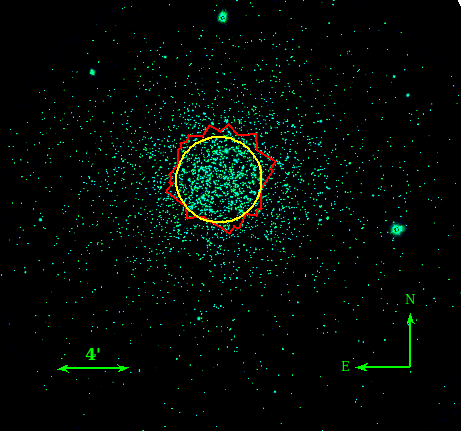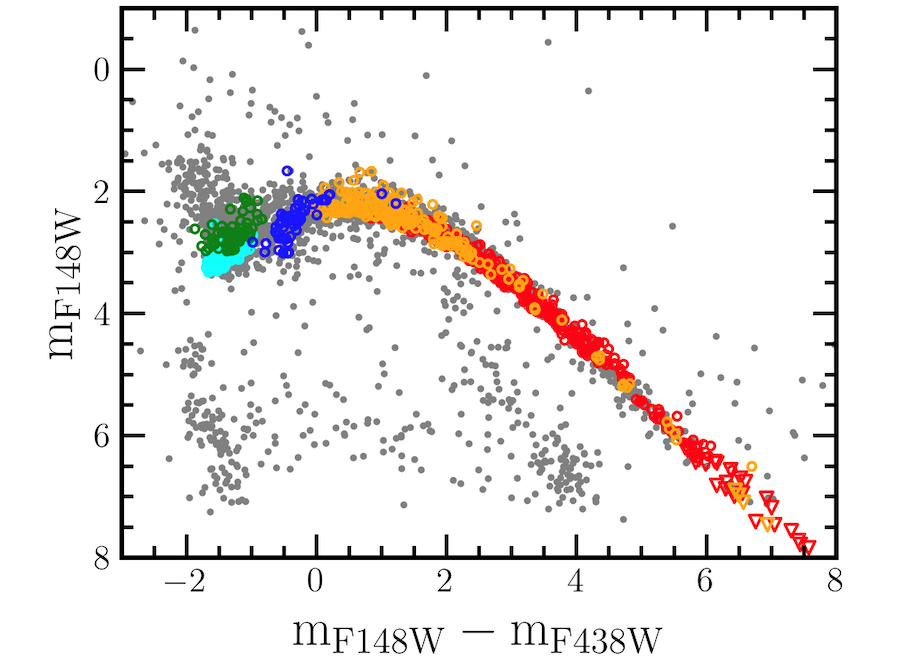A strange class of high-temperature stars detected in the globular cluster Omega Centauri, the largest-known globular cluster in the Milky Way may provide clues to its formation.
Globular clusters are spherical aggregates of several thousand to millions of stars bound by gravity. These systems are thought to have formed early on in the Universe and can serve as perfect astrophysical laboratories for astronomers to understand how stars evolve through various phases. Omega Cen, believed to be the remnant of a small galaxy gravitationally disrupted long ago by the Milky Way, currently hosts less massive stars than our Sun. After exhausting the hydrogen fuel in their core, these stars will eventually swell up to become red giants, having an inert helium core inside a shell fusing hydrogen. Later, they shed a lot of mass from their outer envelopes but extend their lives further by fusing helium in their cores to form carbon. At this stage, they are known as horizontal branch (HB) stars, with only a thin layer of material covering their super-hot cores. The range of mass lost at the red giant branch determines the thickness of the envelope of HB stars and hence their surface temperatures, which can be anywhere between 5000 K to more than 36,000 K. Studying these stars can help answer pressing questions in stellar astrophysics about the thickness of the envelope, the origin of mass loss in their red giant phase and so on.
The solutions to such questions are crucial to understand what happens when the helium runs out in the stellar core. For example, a star with a larger envelope may age and go on to the luminous asymptotic giant phase, shed most of its envelope, generating copious amounts of stardust (processed elements and molecules by the star), and finally, end up as dead remnants (white dwarf). On the other hand, HB stars with thinner envelopes end up directly as white dwarfs. In their late evolutionary phases, such hot stars shine most of their light at ultraviolet wavelengths.
To answer some of the above questions, a team of astronomers led by scientists at the Indian Institute of Astrophysics and their international collaborators decided to study the most massive globular cluster system in our galaxy, Omega Centauri, in the far-ultraviolet. Surprisingly, they detected strange hot stars in the cluster using the Ultra Violet Imaging Telescope (UVIT) images on AstroSat (India's first dedicated space observatory, which has been operating since 2015). They found that these hot stars emitted much less ultraviolet radiation than expected from theoretical models and, in comparison with stars of another globular cluster, M13, having similar overall properties.
Institute of Astrophysics combined the data from UVIT with archival data from other telescopes like Hubble Space Telescope and Gaia and used diagnostic plots called colour-magnitude diagrams (CMDs) to separate stars in various evolutionary phases. The quantities plotted in these diagrams are the brightness of the stars either in visible light or in ultra-violet light (a proxy for the star's luminosity) against the ratio of the intensity in two wavelengths (a proxy for the star's surface temperature).
“To our surprise, we found that the hot HB stars and white dwarfs in Omega Centauri were somewhat strange, that they emit relatively less light in the ultraviolet,” said Prof. Annapurni Subramaniam, a co-author, and Director of IIA. The team investigated this anomaly further by simulating the distribution of the HB stars in the Far Ultraviolet(FUV) - optical CMD. The cluster was found to consist of at least five populations of stars with varying ages and chemical compositions, including those formed with significantly high content of helium.
The enhancement in helium could be one of the reasons for the lesser far-ultraviolet radiation emitted by these stars. About 24% of the HB stars were found to be helium enriched and older and segregated towards the cluster centre than those with normal helium content. “We could therefore conclude that these second-generation helium-enhanced stars were formed from the gas ejected by the cluster's first-generation giant stars, " said Deepthi, thrilled by her research work being published in one of the high impact factor journals in Astronomy & Astrophysics. The properties of the detected white dwarfs indicated that most of these could be made of helium cores and are the end-products of helium-enhanced stars. This research work published in the journal, The Astrophysical Journal Letters provides clues to the formation history of the globular cluster.
Publication link:
https://iopscience.iop.org/article/10.3847/2041-8213/ac9901/pdf
For further details, contact deepthi[dot]prabhu[at]iiap[dot]res[dot]in

Figure 1: A false colour image of the globular cluster Omega Centauri obtained using AstroSat/UVIT. The stars, as seen using the FUV filter, F148W, are shown in green colour. The red boundary indicates the field of view observed by the Hubble Space Telescope, and the yellow circular border represents the extent of the cluster core.
The authors find that from the inside to outside, there are 5 generations of hot stars that have an initial helium fraction from 23% to 43%, in the age range of 11-13 billion years and other chemical differences.

Figure -2: The brightness of the hot stars in the UV is shown in the y-axis versus the relative brightness in UV with respect to the visual brightness. Note that the light blue, blue and green points were expected fall in the same line as the red-orange stars, instead, these points are found deviating. Authors performed detailed simulations to compare the observation with the models that required 5 generations of stars to fit the observed distribution of hot stars (2 times to 10 times hotter than the Sun). The generations are shown in 5 different colours.


























